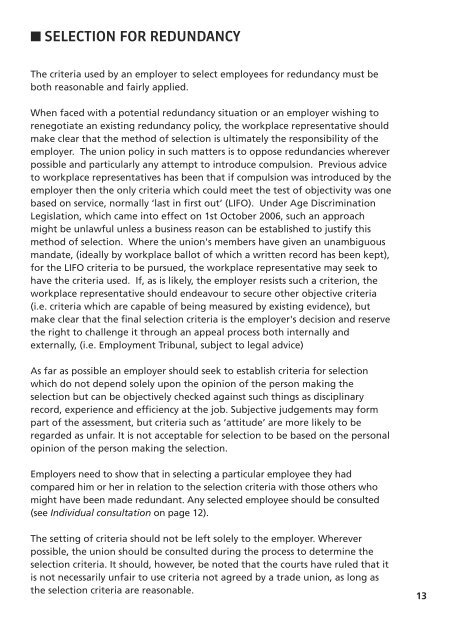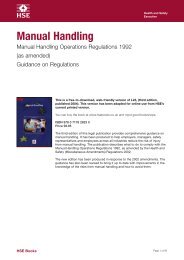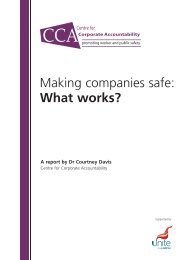Redundancy - Unite the Union
Redundancy - Unite the Union
Redundancy - Unite the Union
You also want an ePaper? Increase the reach of your titles
YUMPU automatically turns print PDFs into web optimized ePapers that Google loves.
n SELECTION FOR REDUNDANCY<br />
The criteria used by an employer to select employees for redundancy must be<br />
both reasonable and fairly applied.<br />
When faced with a potential redundancy situation or an employer wishing to<br />
renegotiate an existing redundancy policy, <strong>the</strong> workplace representative should<br />
make clear that <strong>the</strong> method of selection is ultimately <strong>the</strong> responsibility of <strong>the</strong><br />
employer. The union policy in such matters is to oppose redundancies wherever<br />
possible and particularly any attempt to introduce compulsion. Previous advice<br />
to workplace representatives has been that if compulsion was introduced by <strong>the</strong><br />
employer <strong>the</strong>n <strong>the</strong> only criteria which could meet <strong>the</strong> test of objectivity was one<br />
based on service, normally ‘last in first out’ (LIFO). Under Age Discrimination<br />
Legislation, which came into effect on 1st October 2006, such an approach<br />
might be unlawful unless a business reason can be established to justify this<br />
method of selection. Where <strong>the</strong> union's members have given an unambiguous<br />
mandate, (ideally by workplace ballot of which a written record has been kept),<br />
for <strong>the</strong> LIFO criteria to be pursued, <strong>the</strong> workplace representative may seek to<br />
have <strong>the</strong> criteria used. If, as is likely, <strong>the</strong> employer resists such a criterion, <strong>the</strong><br />
workplace representative should endeavour to secure o<strong>the</strong>r objective criteria<br />
(i.e. criteria which are capable of being measured by existing evidence), but<br />
make clear that <strong>the</strong> final selection criteria is <strong>the</strong> employer's decision and reserve<br />
<strong>the</strong> right to challenge it through an appeal process both internally and<br />
externally, (i.e. Employment Tribunal, subject to legal advice)<br />
As far as possible an employer should seek to establish criteria for selection<br />
which do not depend solely upon <strong>the</strong> opinion of <strong>the</strong> person making <strong>the</strong><br />
selection but can be objectively checked against such things as disciplinary<br />
record, experience and efficiency at <strong>the</strong> job. Subjective judgements may form<br />
part of <strong>the</strong> assessment, but criteria such as ‘attitude’ are more likely to be<br />
regarded as unfair. It is not acceptable for selection to be based on <strong>the</strong> personal<br />
opinion of <strong>the</strong> person making <strong>the</strong> selection.<br />
Employers need to show that in selecting a particular employee <strong>the</strong>y had<br />
compared him or her in relation to <strong>the</strong> selection criteria with those o<strong>the</strong>rs who<br />
might have been made redundant. Any selected employee should be consulted<br />
(see Individual consultation on page 12).<br />
The setting of criteria should not be left solely to <strong>the</strong> employer. Wherever<br />
possible, <strong>the</strong> union should be consulted during <strong>the</strong> process to determine <strong>the</strong><br />
selection criteria. It should, however, be noted that <strong>the</strong> courts have ruled that it<br />
is not necessarily unfair to use criteria not agreed by a trade union, as long as<br />
<strong>the</strong> selection criteria are reasonable.<br />
13

















